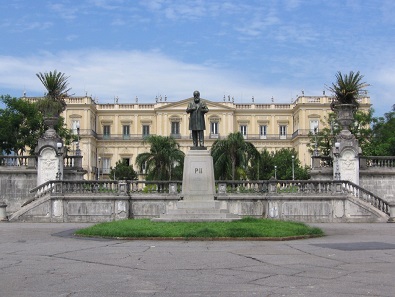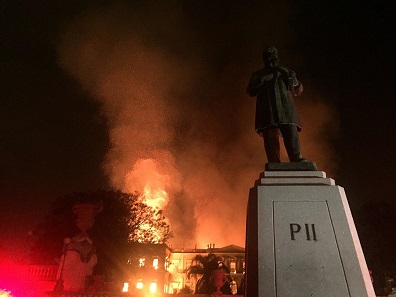Written by Leonie Schulze
September 13, 2018 – On September 2, 2018, a large fire destroyed the National Museum of Brazil in Rio de Janeiro. Merely the outer walls are left standing. For more than 5 hours, firefighters attempted to extinguish the raging flames. The fact that they could not find a single working fire hydrant on the museum’s compound is indicative of the lack of financial support of Brazilian culture and science.
The museum moved into the Paço de São Cristóvão in 1892. Image: Paulo Roberto C M Jr. / CC BY-SA 3.0.
Latin America’s biggest museum of nature history and ethnology celebrated its 200th anniversary in June of 2018. It was founded by King João VI in 1818. In the following two centuries impressive geological, botanical, paleontological, and archaeological collections were compiled in the museum. In 1892, it moved into the Paço de São Cristóvão, the former royal palace that has now burned down.
Numerous museum employees and citizens gathered in front of the ruins in the days following the fire. Most of them blame the Brazilian government for this catastrophe. Although it was known that the building was run-down and vulnerable to fire, the museum’s budget had amounted to a mere 84,000 US dollars in the past year. The country, which had invested 3.6 million dollars into the construction of new and renovation of old stadiums in the context of the 2014 FIFA World Cup, refused to transfer the necessary funds to the museum for years. According to the museum’s deputy director Luiz Fernando Dias Duarte, a third of that money would have sufficed to refurbish the museum.
An image of the burning museum. Image: Felipe Milanez / CC BY-SA 4.0.
Therefore, the catastrophic fire did not come as a surprise for many Brazilians. The German news outlet Die Tagesschau quoted artist Marcia Tiburi as follows: “This is a metaphor for what is happening with Brazil […] It is the result of the neoliberal austerity policies.” Museum employee Márcia Couri told the German newspaper Die Zeit in an interview that the museum had finally received five million euros from the government just shortly before the fire broke out. Well, the money came in too late.
The entire cope of the damage cannot be assessed yet. Multiple news sources have reported that up to 20 million objects have been destroyed – a devastating loss for research and science. Some of the lost objects include: the skeleton of a Maxakalisaurus which lived about 80 million years ago, archaeological objects from Brazil’s pre-Columbian period testifying to the trade patterns of indigenous peoples, as well as gravestones and mummies from Egypt. In addition, a fresco from the ISIS temple in Pompeii as well as numerous vases, mirrors, jugs and other items from ancient Greece and Rome were destroyed. The approx. 11,500 year-old skeleton of the “Luzia” woman was also burned. Up to 500,000 were lost in the fire. Only a few mussels and snails from the mollusk section were carried out of the museum by employees. A meteorite, which had been found in 1784, survived the fire.
The most important national coin collection was not stored at the National Museum – fortunately for numismatics. It is kept at the National Historical Museum in Rio de Janeiro.
After the fire, numerous countries offered their help and financial assistance in the reconstruction of them museum. Germany will provide up to one million euros for the salvage and restoration of surviving items. French President Emmanuel Macron has pledged to send experts to Brasil in support of reconstruction efforts.
The website of the National Museums allows you to have a look at many of the lost objects.
In this PBS NewsHour report, the museum’s director, a descendant of the Portuguese-Brazilian royal family and others voice their opinion on the current administration and the fire.
This video takes you on a virtual tour of the museum before the fire.
Rio de Janeiro students initated a project to salvage images of lost exhibition objects just hours after the fire had been extinguished.






